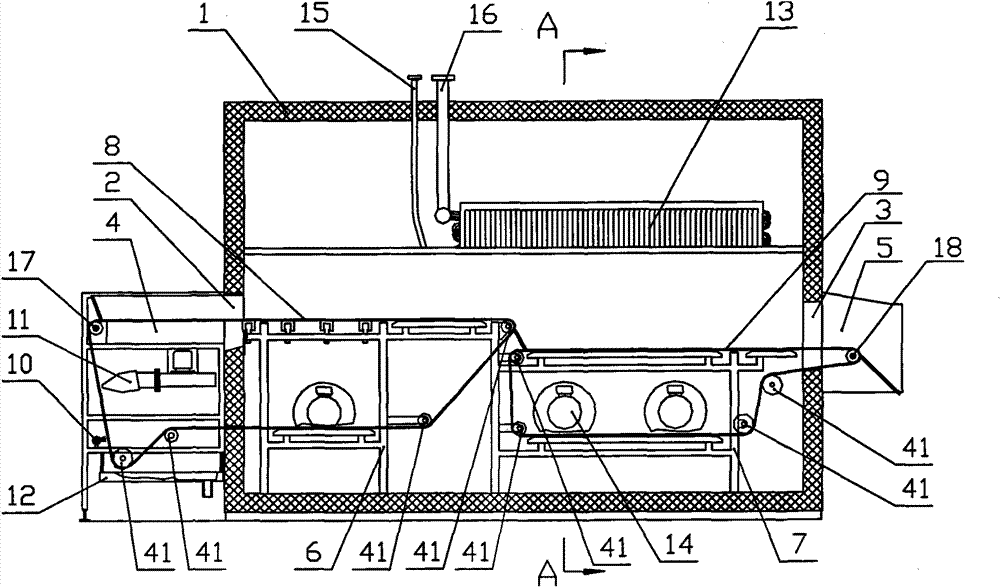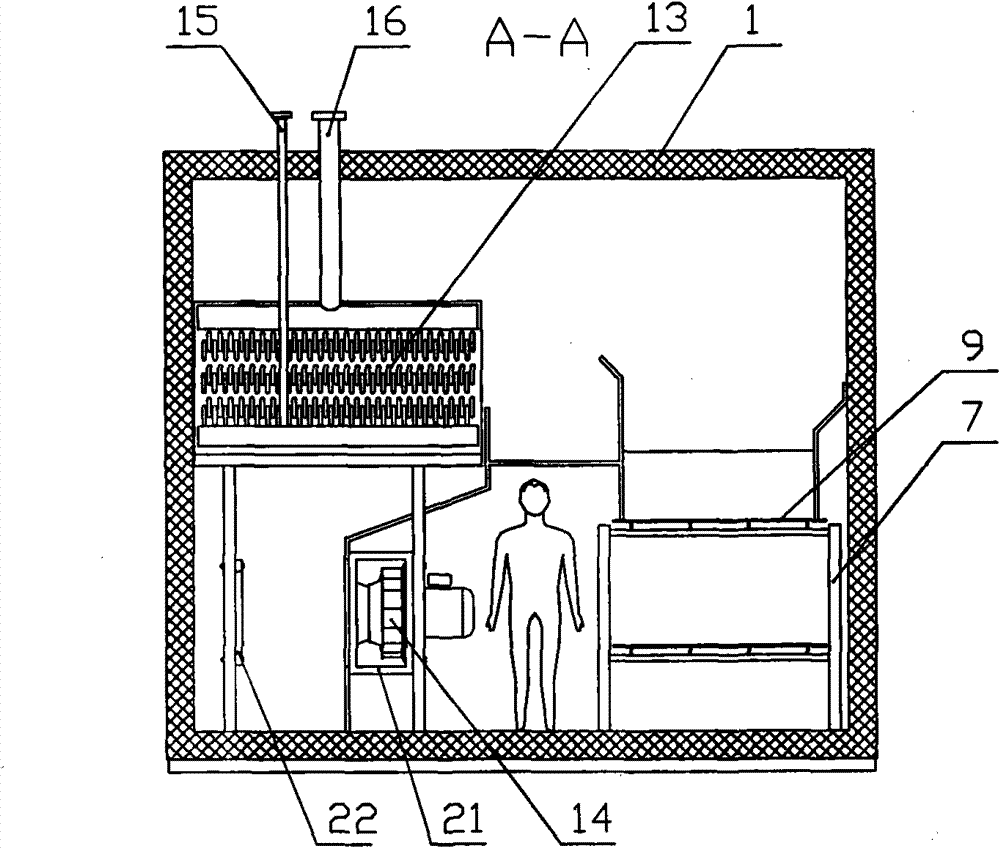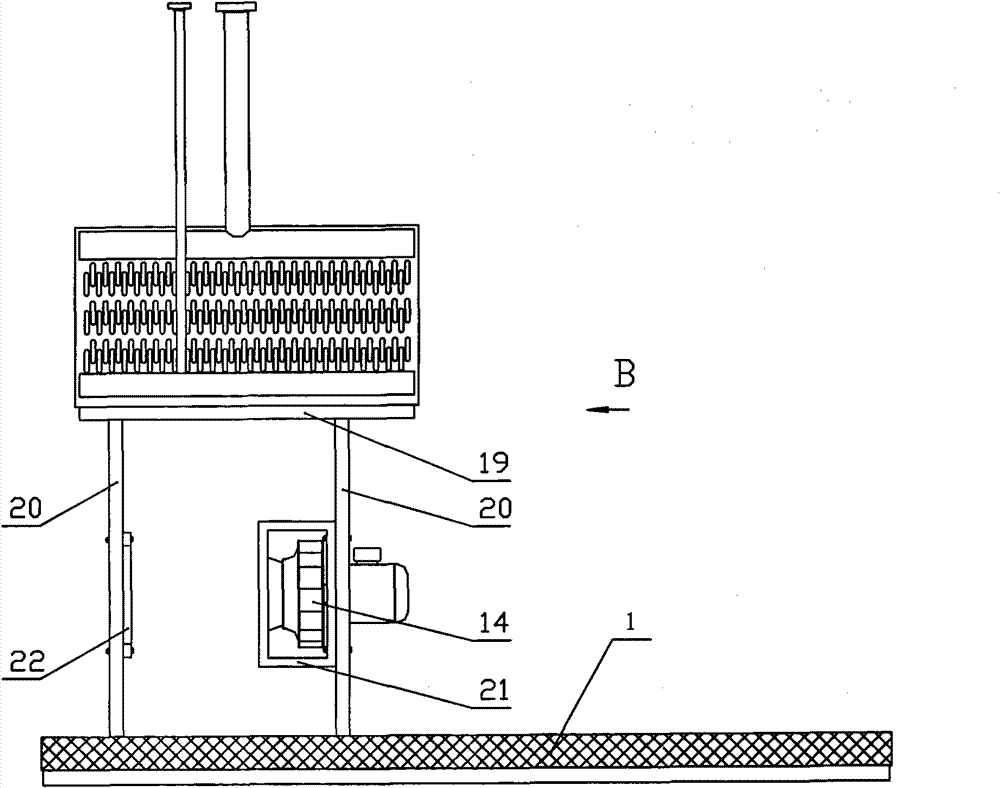Freezing device
A freezing device and anti-icing technology, which is used in household refrigeration devices, coolers, lighting and heating equipment, etc., to achieve the effects of reducing health hazards, stable structure and good cleaning effect.
- Summary
- Abstract
- Description
- Claims
- Application Information
AI Technical Summary
Problems solved by technology
Method used
Image
Examples
Embodiment 1
[0033] Freezing device (see figure 1 , figure 2 ) Including the insulated box 1, the feeding mechanism 4 and the discharging mechanism 5 respectively placed in the inlet 2 and outlet 3 of the insulated box 1, and the feeding conveyor belt frame 6 installed in the insulated box 1. And the discharge conveyor belt frame 7, respectively installed on the infeed conveyor belt frame 6 and the discharge conveyor belt frame 7, the first section of the circulating conveyor belt 8 and the second section of the circulating conveyor belt 9, located in the feeding mechanism 4 The flushing device 10, the blowing device 11, and the water collecting pan 12 below are located in the heat-insulating box 1 and are a cooler composed of a top blowing evaporator 13 and a horizontal centrifugal fan 14. The liquid supply pipe 15 and the air return pipe 16 of the top blowing evaporator 13 are respectively connected to the refrigeration unit. The drive shaft roller 17 of the first section of the circulati...
Embodiment 2
[0035] The difference from Example 1 is: the insulating box 1 has an anti-icing bracket 23 (see Figure 5 , Image 6 , Figure 7 ), the two ends of the anti-icing bracket 23 are fixedly connected with the mounting plate 24 and the feeding conveyor belt frame 6. The upper plane 25 and the two side faces 26 of the anti-icing bracket 23 are basically made of polytetrafluoroethylene material to form a polytetrafluoroethylene supporting surface. There is a PTFE material between the upper plane 25 and the two side faces 26. Wear-resistant strips 27 of ultra-high molecular weight polyethylene material. 28 is a mounting screw, 29 is a mounting screw, and 30 is a mounting nut. The polytetrafluoroethylene sleeve 31 is connected to the mounting screw 29 with a split pin 32. There is at least one anti-icing bracket 23 under the first stage of the circulating conveyor belt 8, and multiple anti-icing brackets 23 may also be provided.
Embodiment 3
[0037] The difference from embodiment 1 or 2 is: the first section of the circulating conveyor belt 8 at the inlet 2 of the insulated box 1 has a steam heating windshield device 33 (see Figure 8 , Picture 9 , Picture 10 ), the wind deflector 34 of the steam-heated wind deflector 33 is fixedly connected to the insulated box 1 5 The upper plane 35 of the air heating windshield device 33 and the lower edge of the polytetrafluoroethylene side surface 26 of the anti-icing bracket 23 meet and incline the outside of the insulated box 1 downward. The wind deflector 34 and the upper plane 35 are fixed on the heating pipe 37 with a heat conducting plate 36. A steam pipe 38 is inserted into the heating pipe 37. There is a steam return pipe 39 at the bottom of the heating pipe 37. The steam passes into the steam pipe 38 and enters the heating pipe 37. It then flows out through the return steam pipe 39.
PUM
 Login to View More
Login to View More Abstract
Description
Claims
Application Information
 Login to View More
Login to View More - R&D
- Intellectual Property
- Life Sciences
- Materials
- Tech Scout
- Unparalleled Data Quality
- Higher Quality Content
- 60% Fewer Hallucinations
Browse by: Latest US Patents, China's latest patents, Technical Efficacy Thesaurus, Application Domain, Technology Topic, Popular Technical Reports.
© 2025 PatSnap. All rights reserved.Legal|Privacy policy|Modern Slavery Act Transparency Statement|Sitemap|About US| Contact US: help@patsnap.com



